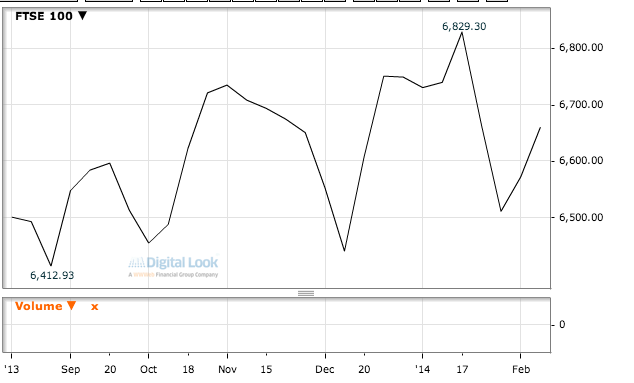
Another positive week for the markets this week to follow last weeks recovery in sentiment.
At 6,663, the FTSE 100 registered a 1.4% rise for the week. The S&P 500 index closed the week at 1,839 and gained 2.3% over the week. The Dow Jones Industrial Average closed Friday at 16,154, up 2.3% for the week. The Nasdaq Composite finished at 4,244, a 2.9% gain over the week.

The big move over the week was gold, which moved up 5% to $1,320 an ounce, a three month high, meaning it is up 9.5% for 2014 but still down 19% in the last 12 months.
Gold miners like African Barrick gold finished up 22% for the week at 273p, Petropavlovsk up 25% at 91p and large cap Randgold Resources moved up 8% over the week to finish at 4774p. African Barrick benefited from the rebound in gold prices and a strong set of results earlier in the week which showed strong progress in cutting costs at its mines in Tanzania.
The reason for the rebound in gold was renewed interest in ETF’s, a technical break out from a 200 day moving average (last seen in August 2012) and muted U.S. manufacturing data caused by the poor weather which weakened the the dollar and lifted the yellow metal’s currency hedge appeal. The SPDR GoldTrust, the world’s largest gold-backed exchange-traded Fund had its largest inflow since late December 2013.
However, the 14-day relative strength index (RSI) for spot gold jumped to about 74, with a reading above 70 being considered to be in overbought territory. Any sign of vigour in the US dollar could send Gold tumbling again. But for now the forecasts of $1000 an ounce gold seem to be wide of the mark. The Federal Reserve’s attitude to tapering is key as well as inflation expectations. Certainly in Europe, deflation seems more of a risk than inflation.
With the US earnings season coming to an end, the focus is back on economic data and the wild weather in America is likely to have an impact on employment and GDP data.
On Friday it was announced that US industrial production fell 0.3% in January. Forecasters has expected a 0.2% gain, with manufacturing output dropping 0.8%, and mining output falling 0.9%.
Eurozone GDP rose 0.3% in the final three months of 2013, with Italy ending its two year recession with a 0.1% growth (though its economy contracted by 1.9% in 2013). This was up from 0.1% growth in the previous quarter and the third quarter of growth since the end of an 18-month recession. Across the whole 28-nation EU, including the UK, growth for the fourth quarter of 2013 was 0.4%. But economic activity is still 2.7% below 2008 levels.
The key country in the Eurozone, Germany, saw its GDP grow by 0.4% in the final quarter of 2013, after 0.3% in the previous three months which was better than forecasts. Germany’s economy grew by 1.3% in 2013. Moody’s raised its outlook for Italy’s government bond rating to stable from negative Friday, citing a projected levelling off of the government debt-to-GDP ratio and reduced likelihood that Italian banks will need government assistance.
Plenty of volatility to contend with, but the green shoots of economic growth appear to be alive and well in Europe, though the pace of growth on both sides of the Atlantic are unclear. The question remains about how Asia and notably China will perform in coming months. I will be watching the gold price with interest – $1000, $1200 or $1400?
Contrarian Investor UK
IMPORTANT: The posts I make are in no way meant as investment suggestions or recommendations to any visitors to the site. They are simply my views, personal reflections and analysis on the markets. Anyone who wishes to spread bet or buy stocks should rely on their own due diligence and common sense before placing any spread trade.
by contrarianuk
Gold price rebounds this week as US manufacturing data comes in light
Feb 16, 2014 at 8:08 am in Market Commentary by contrarianuk
Another positive week for the markets this week to follow last weeks recovery in sentiment.
At 6,663, the FTSE 100 registered a 1.4% rise for the week. The S&P 500 index closed the week at 1,839 and gained 2.3% over the week. The Dow Jones Industrial Average closed Friday at 16,154, up 2.3% for the week. The Nasdaq Composite finished at 4,244, a 2.9% gain over the week.
The big move over the week was gold, which moved up 5% to $1,320 an ounce, a three month high, meaning it is up 9.5% for 2014 but still down 19% in the last 12 months.
Gold miners like African Barrick gold finished up 22% for the week at 273p, Petropavlovsk up 25% at 91p and large cap Randgold Resources moved up 8% over the week to finish at 4774p. African Barrick benefited from the rebound in gold prices and a strong set of results earlier in the week which showed strong progress in cutting costs at its mines in Tanzania.
The reason for the rebound in gold was renewed interest in ETF’s, a technical break out from a 200 day moving average (last seen in August 2012) and muted U.S. manufacturing data caused by the poor weather which weakened the the dollar and lifted the yellow metal’s currency hedge appeal. The SPDR GoldTrust, the world’s largest gold-backed exchange-traded Fund had its largest inflow since late December 2013.
However, the 14-day relative strength index (RSI) for spot gold jumped to about 74, with a reading above 70 being considered to be in overbought territory. Any sign of vigour in the US dollar could send Gold tumbling again. But for now the forecasts of $1000 an ounce gold seem to be wide of the mark. The Federal Reserve’s attitude to tapering is key as well as inflation expectations. Certainly in Europe, deflation seems more of a risk than inflation.
With the US earnings season coming to an end, the focus is back on economic data and the wild weather in America is likely to have an impact on employment and GDP data.
On Friday it was announced that US industrial production fell 0.3% in January. Forecasters has expected a 0.2% gain, with manufacturing output dropping 0.8%, and mining output falling 0.9%.
Eurozone GDP rose 0.3% in the final three months of 2013, with Italy ending its two year recession with a 0.1% growth (though its economy contracted by 1.9% in 2013). This was up from 0.1% growth in the previous quarter and the third quarter of growth since the end of an 18-month recession. Across the whole 28-nation EU, including the UK, growth for the fourth quarter of 2013 was 0.4%. But economic activity is still 2.7% below 2008 levels.
The key country in the Eurozone, Germany, saw its GDP grow by 0.4% in the final quarter of 2013, after 0.3% in the previous three months which was better than forecasts. Germany’s economy grew by 1.3% in 2013. Moody’s raised its outlook for Italy’s government bond rating to stable from negative Friday, citing a projected levelling off of the government debt-to-GDP ratio and reduced likelihood that Italian banks will need government assistance.
Plenty of volatility to contend with, but the green shoots of economic growth appear to be alive and well in Europe, though the pace of growth on both sides of the Atlantic are unclear. The question remains about how Asia and notably China will perform in coming months. I will be watching the gold price with interest – $1000, $1200 or $1400?
Contrarian Investor UK
IMPORTANT: The posts I make are in no way meant as investment suggestions or recommendations to any visitors to the site. They are simply my views, personal reflections and analysis on the markets. Anyone who wishes to spread bet or buy stocks should rely on their own due diligence and common sense before placing any spread trade.